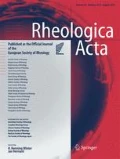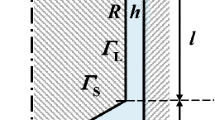Abstract
The orthogonal superposition (OSP) technique is advantageous for measuring structural dynamics in complex fluids subjected to a primary shear flow. This technique superimposes a small-amplitude oscillation orthogonal to a primary shear flow to measure the real and imaginary components of the complex shear modulus. The commercial availability of OSP geometries and bi-axial transducers is expected to increase its adoption as a more routine rheological technique. It is important to understand calibration procedures and the influence of intrinsic inhomogeneous flow fields, residual pumping flow effects, and boundary forces at the leading edges of the geometry components on experimental error and measurement uncertainty. In this work, we perform calibration measurements of viscosity standards on a commercial shear rheometer using a double-wall concentric cylinder geometry. Newtonian calibration fluids with viscosities that range from 0.01 to 331 Pa s are used to obtain the end-effect factors in primary steady shear and orthogonal oscillatory shear directions. The corrections needed for the viscosity measured in steady shear range from 16 to 21%; whereas for the orthogonal complex viscosity, the errors range from 19 to 25%. Computational fluid dynamics simulations are used to understand the relationship between the end-effect corrections, OSP flow cell, and the imposed shear flow fields. We show that approximate linear shear deformation profiles are attained, in the double gap, for both primary rotational shear and orthogonal oscillatory shear deformation, with only a slight deviation for the fluid in the vicinity of the bob ends. We also present information on the velocity, pressure, and shear rate distributions for fluid within the entire flow cell. The overestimation of the orthogonal viscosity is attributed to the pressure forces exerted on the bob end surfaces (9%) and a higher shear rate in the double gap that leads to higher viscous stresses on the bob cylindrical surfaces (8%). The Newtonian fluid field information provides a benchmark for future simulations involving non-Newtonian fluids. Additionally, the operational knowledge (i.e., consistent sample filling) and measurement window (i.e., viscosity and frequency) described within are critical for proper use of the instrument and measurement accuracy.







Similar content being viewed by others
Abbreviations
- R 1 :
-
inside cup radius (m)
- R 2 :
-
inside bob radius (m)
- R 3 :
-
outside bob radius (m)
- R 4 :
-
outside cup radius (m)
- R b :
-
average radius of the bob (m)
- R a :
-
difference between Rb and the average gap width (m), defined in Eq. 4
- l :
-
inner cylinder height (m)
- h :
-
bob effective length (m)
- c L :
-
primary end-effect factor
- c Lo :
-
orthogonal end-effect factor
- K τ :
-
primary stress constant (Pa N−1 m−1)
- K τo :
-
orthogonal stress constant (Pa N−1)
- K γ :
-
primary strain constant (rad−1)
- K γo :
-
orthogonal strain constant (m−1)
- M :
-
torque (N m)
- F ⊥ :
-
orthogonal oscillation force (N)
- \( {G}_{\perp}^{\ast } \) :
-
orthogonal complex shear modulus (Pa)
- fh :
-
fluid height (m)
- d :
-
upper opening height (m)
- D :
-
gap width (m)
References
Birnboim MH, Ferry JD (1961) Method for measuring dynamic mechanical properties of viscoelastic liquids and gels; the gelation of polyvinyl chloride. J Appl Phys 32:2305–2313
Colombo G, Kim S, Schweizer T, Schroyen B, Clasen C, Mewis J, Vermant J (2017) Superposition rheology and anisotropy in rheological properties of sheared colloidal gels. J Rheol 61:1035–1048
COMSOL AB (2018) CFD Modules User’s Guide, COMSOL Multiphysics™ v. 5.4. COMSOL AB, Stockholm, Sweden
Ewoldt RH, Johnston MT, Caretta LM (2015) Experimental challenges of shear rheology: how to avoid bad data. In: Spagnolie S. (eds) Complex Fluids in Biological Systems. Biological and Medical Physics, Biomedical Engineering. Springer, New York, NY, pp 207–241
Franck A (2013) Orthogonal superposition on the ARES-G2. TA instruments, application note, APN035
Gracia-Fernández C, Gómez-Barreiro S, Elmoumni A, Álvarez A, López-Beceiro J, Artiaga R (2015) Simultaneous application of electro and orthogonal superposition rheology on a starch/silicone oil suspension. J Rheol 60:121–127
Highgate DJ, Whorlow RW (1969) End effects and particle migration effects in concentric cylinder rheometry. Rheol Acta 8:142–151
International Organization for Standardization (1993) ISO 3219 Plastics – polymers/resins in the liquid state or as emulsions or dispersions – determination of viscosity using a rotational viscometer with defined shear rate
ISO/IEC GUIDE 98–3 (2008) [JCGM/WG1/100] Uncertainty of measurement — Part 3: guide to the expression of uncertainty in measurement (GUM:1995)
Jacob AR, Poulos AS, Kim S, Vermant J, Petekidis G (2015) Convective cage release in model colloidal glasses. Phys Rev Lett 115:218301
Jacob AR, Poulos AS, Semenov AN, Vermant J, Petekidis G (2019) Flow dynamics of concentrated starlike micelles: a superposition rheometry investigation into relaxation mechanisms. J Rheol 63:641–653
Khandavalli S, Hendricks J, Clasen C, Rothstein JP (2016) A comparison of linear and branched wormlike micelles using large amplitude oscillatory shear and orthogonal superposition rheology. J Rheol 60:1331–1346
Kim S, Mewis J, Clasen C, Vermant J (2013) Superposition rheometry of a wormlike micellar fluid. Rheol Acta 52:727–740
Kobayashi H, Nashima T, Okamoto Y, Kaminaga F (1991) End effect in a coaxial cylindrical viscometer. Rev Sci Instrum 62:2748–2750
Krieger IM (1968) Shear rate in the Couette viscometer. Trans Soc Rheol 12:5–11
Krieger IM, Elrod H (1953) Direct determination of the flow curves of non-Newtonian fluids. II shearing rate in the concentric cylinder viscometer. J Appl Phys 24:134–136
Lafarge T, Possolo A (2015) The NIST uncertainty machine. NCSLI Measure J Meas Sci 10:20–27. https://uncertainty.nist.gov
Läuger J, Stettin H (2016) Effects of instrument and fluid inertia in oscillatory shear in rotational rheometers. J Rheol 60:393–406
Lin NYC, Ness C, Cates ME, Sun J, Cohen I (2016) Tunable shear thickening in suspensions. Proc Natl Acad Sci U S A 113:10774–10778
Lindsley CH, Fischer EK (1947) End-effect in rotational viscometers. J Appl Phys 18:988–996
Macosko CW (1994) Rheology: principles, measurements, and applications. VCH, New York, NY
Mewis J, Schoukens G (1978) Mechanical spectroscopy of colloidal dispersions. Faraday Discuss Chem Soc 65:58–64
Mewis J, Kaffashi B, Vermant J, Butera RJ (2001) Determining relaxation modes in flowing associative polymers using superposition flows. Macromolecules 34:1376–1383
Moffatt HK (1964) Viscous and resistive eddies near a sharp corner. J Fluid Mech 18:1–18
Moghimi E, Vermant J, Petekidis G (2019) Orthogonal superposition rheometry of model colloidal glasses with short-ranged attractions. J Rheol 63:533–546
Philippoff W (1934) Dynamische Untersuchungen an kolloiden Systemen. I Grundlagen und Methode. Phys Z 35:884–900
Potanin AA, Shrauti SM, Arnold DW, Lane AM, Mellema J (1997) Testing the structure of magnetic paints with and without superimposed shear. J Rheol 41:1337–1347
Princen HM (1985) Rheology of foams and highly concentrated emulsions. II experimental study of the yield stress and wall effects for concentrated oil-in-water emulsions. J Colloid Interface Sci 105:150–171
Schrag JL (1977) Deviation of velocity gradient profiles from the “gap loading” and “surface loading” limits in dynamic simple shear experiments. Trans Soc Rheol 21:399–413
Simmons JM (1966) A servo-controlled rheometer for measurement of the dynamic modulus of viscoelastic liquids. J Sci Instrum 43:887–892
Simmons JM (1968) Dynamic modulus of polyisobutylene solutions in superposed steady shear flow. Rheol Acta 7:184–188
Smith TL, Ferry JD, Schremp FW (1949) Measurements of the mechanical properties of polymer solutions by electromagnetic transducers. J Appl Phys 20:144–153
Sung SH, Kim S, Hendricks J, Clasen C, Ahn KH (2018) Orthogonal superposition rheometry of colloidal gels: time-shear rate superposition. Soft Matter 14:8651–8659
Tanner RI, Williams G (1971) On the orthogonal superposition of simple shearing and small-strain oscillatory motions. Rheol Acta 10:528–538
van der Vorst B, van den Ende D, Tekin NA, Mellema J (1998) Viscoelastic behavior of an ordering latex suspension in a steady shear flow. Phys Rev E 57:3115–3122
Vermant J, Moldenaers P, Mewis J, Ellis M, Garritano R (1997) Orthogonal superposition measurements using a rheometer equipped with a force rebalanced transducer. Rev Sci Instrum 68:4090–4096
Vermant J, Walker L, Moldenaers P, Mewis J (1998) Orthogonal versus parallel superposition measurements. J Non-Newtonian Fluid Mech 79:173–189
Walker LM, Vermant J, Moldenaers P, Mewis J (2000) Orthogonal and parallel superposition measurements on lyotropic liquid crystalline polymers. Rheol Acta 39:26–37
White CC, Schrag JL (1999) Theoretical predictions for the mechanical response of a model quartz crystal microbalance to two viscoelastic media: a thin sample layer and surrounding bath medium. J Chem Phys 111:11192–11206
Yamamoto M (1971) Rate-dependent relaxation spectra and their determination. Trans Soc Rheol 15:331–344
Yang TMT, Krieger IM (1978) Comparison of methods for calculating shear rates in coaxial viscometers. J Rheol 22:413–421
Zeegers J, van den Ende D, Blom C, Altena EG, Beukema GJ, Mellema J (1995) A sensitive dynamic viscometer for measuring the complex shear modulus in a steady shear flow using the method of orthogonal superposition. Rheol Acta 34:606–621
Acknowledgments
The authors thank Prof. Jan Vermant (ETH Zurich), Dr. Paul Salipante (NIST), and Dr. Fred Phelan (NIST) for their insights and expertise that greatly assisted this research. We also thank Dr. Siva Tholeti (COMSOL, Inc.) for the advices on simulation and the communications with TA Instruments Rheology team that sparked our initial interest in this research. Dr. Ryan Murphy and Dr. Paul Butler (NIST) are acknowledged for the assistance with the access of the rheometer and OSP geometry at NIST NCNR. We thank Dr. Paul Salipante (NIST) for the careful review of an early draft.
Greek letters
ω⊥ bob orthogonal oscillatory shear frequency (rad/s)
γ⊥ bob orthogonal oscillatory shear strain amplitude
τ shear stress (Pa)
\( \dot{\gamma} \)shear rate (s−1)
Ω cup angular velocity (rad/s)
η|| primary steady shear viscosity (Pa s)
\( {\eta}_{\perp}^{\ast } \)orthogonal complex viscosity (Pa s)
θ⊥ orthogonal oscillation displacement (m)
λs shear wavelength (m)
Funding
Funding from the National Institute of Standards and Technology (Award # 70NANB15H112) is gratefully acknowledged.
Author information
Authors and Affiliations
Corresponding authors
Ethics declarations
Conflict of interest
The authors declare that they have no conflict of interest.
Disclaimer
Certain commercial equipment, instruments, or materials are identified in this paper in order to specify the experimental procedure adequately. Such identification is not intended to imply recommendation or endorsement by the National Institute of Standards and Technology, nor is it intended to imply that the materials or equipment identified are necessarily the best available for the purpose. This paper is an official contribution of the National Institute of Standards and Technology, US Department of Commerce; not subject to copyright in the USA.
Additional information
Publisher’s note
Springer Nature remains neutral with regard to jurisdictional claims in published maps and institutional affiliations.
Rights and permissions
About this article
Cite this article
Tao, R., Forster, A.M. End effect correction for orthogonal small strain oscillatory shear in a rotational shear rheometer. Rheol Acta 59, 95–108 (2020). https://doi.org/10.1007/s00397-019-01185-5
Received:
Revised:
Accepted:
Published:
Issue Date:
DOI: https://doi.org/10.1007/s00397-019-01185-5



